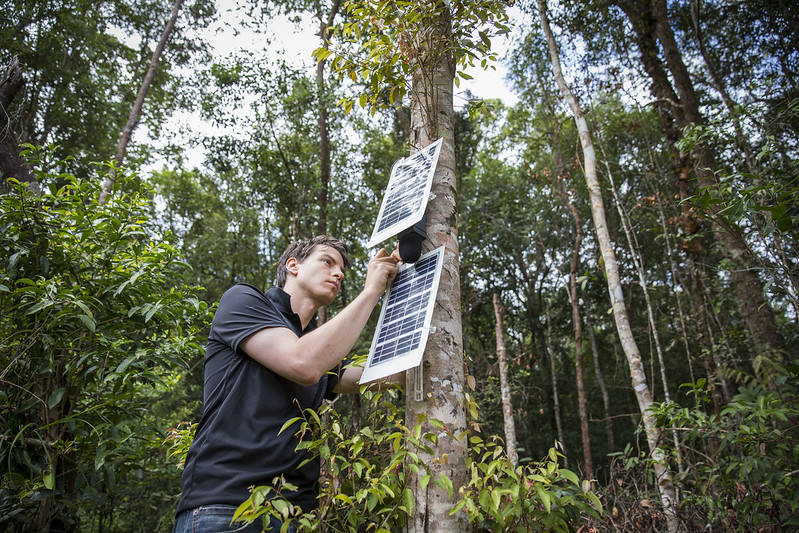Technology and nature make for strange bedfellows, each seemingly divergent with respect to the other. However, nature conservationists have been employing technology to aid their vital work for a long time now…
In 2022, a Wildlabs.net report identified artificial intelligence (AI) as one of the top three emerging technologies in the field of wildlife conservation, helping protect species globally. It might seemingly look like techno-solutionism, but its timing could not be better. We are in a very crucial era, facing increasingly complex ecological challenges to protect our biocultural heritage and the natural world.
Species Distribution and Conservation
Some of the primary tools used to collect data include camera traps, satellite imagery, drones, etc. As technology improves, batteries last longer, memory cards get larger, and image sensors get faster, wildlife conservationists can collect enormous amounts of data for research. They not only automatically detect movements and capture images or videos of passing fauna, but the data is also integrated with databases around the world, providing researchers with real-time information.
However, one of the most significant uses of AI in this field is its ability to analyse these images. Not only can they identify species and recognize specific behaviours, but they also sift through millions of images, throwing up only those that are useful This reduces the need for human intervention and greatly shortens data processing times.
But what is truly the frontier right now is not simply the identification of species but the identification of individuals in that species, say grizzly bears. While it is controversial in the human world, facial recognition technology amongst animal species is paramount in conservation biology. So, if one wants to estimate abundance trends, one needs to know if they are counting the same grizzly bear more than once!
Musical Monitoring
The fact that humpback whales sing to each other is not new, nor is the fact that everything from audio to acoustics is now used to monitor undersea wildlife. However, what if we were to tell you that AI can analyse years of digitized recordings captured by ocean-floor-mounted arrays? While it has not been able to distinguish whale voices yet, AI has been able to extract data on populations, singing patterns, and even seasonality.

According to Research Oceanographer Ann Allen, knowing when and where the whales have sung in the past could possibly understand whether they have changed their distribution patterns over time. There are many other projects lined up, including using AI to decode sperm whale language and identify North Atlantic right whales.
Anti-Poaching Efforts
AI-powered technologies, like sensors, are used for anti-poaching efforts. These algorithms analyse real-time image and video feeds to support Eco-DRR (ecosystem-based disaster risk reduction). They not only help in detecting and identifying wildlife, including endangered species but also in triggering alerts for any possible poaching activities, thus helping law enforcement agencies respond effectively.
For instance, biotech startup and “de-extinction” company Colossal Biosciences and “Save the Elephants” conservationists are employing AI-powered drones to monitor real-time data on African elephant herds and their locations, helping prevent poaching and wildlife-human conflicts. Another Miami-based non-profit, the Brady Hunter Foundation, is using AI collars on rhinos and elephants to monitor their vital signs. At the first sign of abnormal activity or anxiety, they send real-time distress signals via well-placed network towers to the anti-poaching unit immediately,
Another extremely intriguing prospect is analysing sound and audio to protect the environment. Does it sound far-fetched? Because it is already happening. The non-profit organization Rainforest Connection’s fundamental idea is actually ingenious: to listen to the rainforest – literally. It obtains sound from rainforests across 37 countries, recording audio from nearly 2 million acres of land, much of which is remote. Its AI tools trawl this data to, among other things, detect instances of animal poaching and illegal deforestation.
However, their work does not only happen on a computer screen. It also collaborates with indigenous communities and local organizations to guide and deploy effective conservation efforts to stop illegal activities.
eDNA Sampling
All living beings are constantly shedding bits of DNA, called eDNA (environmental DNA), left behind from hair, skin, urine, scales, pollen, and more. Now imagine this very stray eDNA having the power to revolutionize wildlife conservation. eDNA sampling involves the collection and analysis of DNA traces present in environmental samples, like soil or water, to detect the presence of species.
Advances in AI analysis methods and eDNA technologies can improve species detection, especially for cryptic or elusive species, providing potentially valuable information for monitoring diversity and conservation planning.
In the end, the idea is to have AI serve humanity and wider conservation, and not the other way around. The synergy between conservation and AI can potentially enhance our ability to mitigate wildlife-human conflicts, foster sustainable coexistence between wildlife and humanity, and safeguard our ecosystems overall. AI is not merely a technological tool but also a catalyst for empowering conservation efforts and protecting the planet’s biodiversity and the livelihoods of those who depend on it.
Imagine enjoying a wildlife safari with the knowledge that somewhere, technology is working to protect the flora and fauna around. If it sounds incredible, that is because it is.
In case you missed:
- Technology for good – How IoT is driving sustainability
- AI Firewalls and How They Protect Your Data
- IoT and its role in energy transition
- AI+ genomics – Revolutionizing the healthcare industry
- Enterprise Network Transformation: Benefits and Challenges
- Can We Really Opt Out of Artificial Intelligence Online?
- Can we fight climate change with AI?
- AI and Networking Infrastructure – 2024 Trends
- Re-examining Cybersecurity through Blockchain
- Neural Networks vs AI – Decoding the Differences












